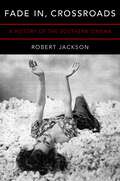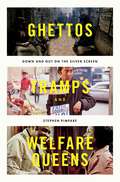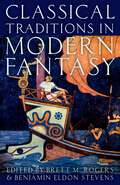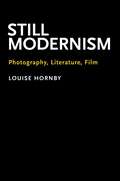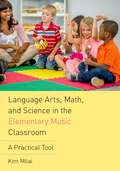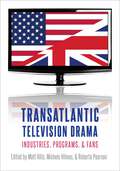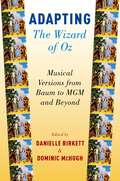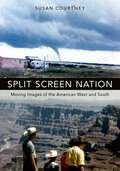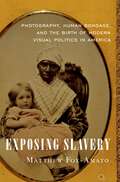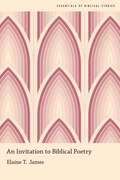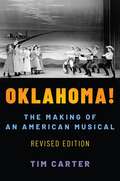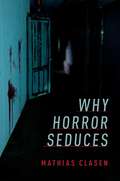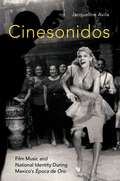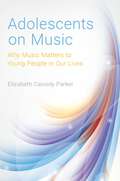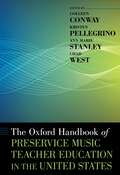- Table View
- List View
FADE IN, CROSSROADS C: A History of the Southern Cinema
by Robert JacksonHow did the US South contribute to the development of film? And how did film shape the modern South? In Fade In, Crossroads, Robert Jackson tells the story of the relationships between southerners and motion pictures from the silent era through the golden age of Hollywood. Jackson reveals the profound consequences of the coincidence of the rise and fall of the American film industry with the rise and fall of the South's most important modern product and export: Jim Crow segregation. He considers southern historical legacies on film, from popular Civil War films and comparably popular lynching films emerging in a time of prolific lynching in the South, to the resilient race film industry whose African American filmmakers forged an independent cinematic movement in defiance of the racial restrictions of both the South and Hollywood. He also traces the influence of film on future participants in the Civil Rights Movement, from prominent leaders such as Martin Luther King and Thurgood Marshall to film-industry veterans like Lena Horne and Paul Robeson to the millions of ordinary people, black and white, who found themselves caught up in the struggle for racial equality in the modern United States.
Ghettos, Tramps, and Welfare Queens: Down and Out on the Silver Screen
by Stephen PimpareGhettos, Tramps, and Welfare Queens: Down & Out on the Silver Screen explores how American movies have portrayed poor and homeless people from the silent era to today. It provides a novel kind of guide to social policy, exploring how ideas about poor and homeless people have been reflected in popular culture and evaluating those images against the historical and contemporary reality. Richly illustrated and examining nearly 300 American-made films released between 1902 and 2015, Ghettos, Tramps, and Welfare Queens finds and describes representations of poor and homeless people and the places they have inhabited throughout the century-long history of U.S. cinema. It moves beyond the merely descriptive to deliberate whether cinematic representations of homelessness and poverty changed over time, and if there are patterns to be discerned. Ultimately, the text offers a preliminary response to a handful of harder questions about causation and consequence: Why are these portrayals as they are? Where do they come from? Are they a reflection of American attitudes and policies toward marginalized populations, or do they help create them? What does this all mean for politics and policymaking? Of interest to movie buffs and film scholars, cultural critics and historians, policy analysts, and those curious to know more about homelessness and American poverty, Ghettos, Tramps, and Welfare Queens is a unique window into American politics, history, policy, and culture -- it is an entertaining and enlightening journey.
Ghettos, Tramps, and Welfare Queens: Down and Out on the Silver Screen
by Stephen PimpareGhettos, Tramps, and Welfare Queens: Down & Out on the Silver Screen explores how American movies have portrayed poor and homeless people from the silent era to today. It provides a novel kind of guide to social policy, exploring how ideas about poor and homeless people have been reflected in popular culture and evaluating those images against the historical and contemporary reality. Richly illustrated and examining nearly 300 American-made films released between 1902 and 2015, Ghettos, Tramps, and Welfare Queens finds and describes representations of poor and homeless people and the places they have inhabited throughout the century-long history of U.S. cinema. It moves beyond the merely descriptive to deliberate whether cinematic representations of homelessness and poverty changed over time, and if there are patterns to be discerned. Ultimately, the text offers a preliminary response to a handful of harder questions about causation and consequence: Why are these portrayals as they are? Where do they come from? Are they a reflection of American attitudes and policies toward marginalized populations, or do they help create them? What does this all mean for politics and policymaking? Of interest to movie buffs and film scholars, cultural critics and historians, policy analysts, and those curious to know more about homelessness and American poverty, Ghettos, Tramps, and Welfare Queens is a unique window into American politics, history, policy, and culture -- it is an entertaining and enlightening journey.
CLASSICAL TRADITIONS IN MODERN FANTASY C
by Brett M. Rogers and Benjamin Eldon StevensClassical Traditions in Modern Fantasy is the first collection of essays in English focusing on how fantasy draws deeply on ancient Greek and Roman mythology, philosophy, literature, history, art, and cult practice. Presenting fifteen all-new essays intended for both scholars and other readers of fantasy, this volume explores many of the most significant examples of the modern genre-including the works of H. P. Lovecraft, J. R. R. Tolkien's The Hobbit, C. S. Lewis's Chronicles of Narnia, J. K. Rowling's Harry Potter series, George R. R. Martin's Game of Thrones series, and more-in relation to important ancient texts such as Aeschylus' Oresteia, Aristotle's Poetics, Virgil's Aeneid, and Apuleius' The Golden Ass. These varied studies raise fascinating questions about genre, literary and artistic histories, and the suspension of disbelief required not only of readers of fantasy but also of students of antiquity. Ranging from harpies to hobbits, from Cyclopes to Cthulhu, and all manner of monster and myth in-between, this comparative study of Classics and fantasy reveals deep similarities between ancient and modern ways of imagining the world. Although antiquity and the present day differ in many ways, at its base, ancient literature resonates deeply with modern fantasy's image of worlds in flux and bodies in motion.
Still Modernism: Photography, Literature, Film
by Louise HornbyStill Modernism offers a critique of the modernist imperative to embrace motion, speed, and mobility. In the context of the rise of kinetic technologies and the invention of motion pictures, it claims that stillness is nonetheless an essential tactic of modernist innovation. More specifically, the book looks at the ways in which photographic stillness emerges as a counterpoint to motion and to film, asserting its own clear visibility against the blur of kinesis. Photographic stillness becomes a means to resist the ephemerality of motion and to get at and articulate something real or essential by way of its fixed limits. Combining art history, film studies and literary studies, Louise Hornby reveals how photographers, filmmakers, and writers, even at their most kinetic, did not surrender attention to points of stillness. Rather, the still image, understood through photography, establishes itself as a mode of resistance and provides a formal response to various modernist efforts to see better, to attend more closely, and to remove the fetters of subjectivity and experience. Still Modernism brings together a series of canonical texts, films, and photographs, the selection of which reinforces the central claim that stillness does not lurk at the margins of modernism, but was constitutive of its very foundations. In a series of comparisons drawing from literary and visual objects, Hornby argues that still photography allows film to access its own diffuse images of motion; photography's duplicative form provides a serial structure for modernist efforts to represent the face; its iterative structure articulates the jerky rhythms of experimental narrative as perambulation; and its processes of development allow for the world to emerge independent of the human observer. Casting new light on the relationship between photography and film, Hornby situates the struggle between the still and the kinetic at the center of modernist culture.
Language Arts, Math, and Science in the Elementary Music Classroom: A Practical Tool
by Kim MilaiLanguage Arts, Math, and Science in the Elementary Music Classroom provides a practical guide to help music teachers incorporate elementary classroom subjects into their curriculum using STEAM (Science, Technology, Engineering, Arts and Math)-inspired strategies, with added emphasis on social studies. It includes a complete elementary music curriculum for kindergarten, first, and second grades, and has cross-referencing charts for regular elementary classroom teachers to find music activities for their classroom. Importantly, it shows teachers how to include the artistic processes of creating, performing, responding, and connecting in their lessons. These processes make up the new music standards featured in NAfME's new Core Arts Music Standards. In order to maximize comprehension, the book includes assessment tests, sheet music, work sheet templates, and brainstorming activities centered on using technology to enhance composition projects. Lesson plans are organized by the calendar year, each inspired by the seasons, American culture, and world culture. These lessons may be used as is or used to generate new curricula altogether.
LANG ARTS, MATH & SCI ELEM MUS CLASS C: A Practical Tool
by Kim MilaiLanguage Arts, Math, and Science in the Elementary Music Classroom provides a practical guide to help music teachers incorporate elementary classroom subjects into their curriculum using STEAM (Science, Technology, Engineering, Arts and Math)-inspired strategies, with added emphasis on social studies. It includes a complete elementary music curriculum for kindergarten, first, and second grades, and has cross-referencing charts for regular elementary classroom teachers to find music activities for their classroom. Importantly, it shows teachers how to include the artistic processes of creating, performing, responding, and connecting in their lessons. These processes make up the new music standards featured in NAfME's new Core Arts Music Standards. In order to maximize comprehension, the book includes assessment tests, sheet music, work sheet templates, and brainstorming activities centered on using technology to enhance composition projects. Lesson plans are organized by the calendar year, each inspired by the seasons, American culture, and world culture. These lessons may be used as is or used to generate new curricula altogether.
Transatlantic Television Drama: Industries, Programs, and Fans
In 2014, the UK science-fiction television series Black Mirror was released on Netflix worldwide, quickly becoming a hit with US audiences. Like other beloved British imports, this series piqued Americans' interest with hints of dark comedy, clever plotlines, and six-episode seasons that left audiences frantic for more. In Transatlantic Television Drama, volume editors Michele Hilmes, Matt Hills, and Roberta Pearson team up with leading scholars in TV studies and transnational television to look at how serial dramas like Black Mirror captivate US audiences, and what this reveals about the ways Americans and Brits relate to each other on and off the screen. Focusing on production strategies, performance styles, and audience reception, chapters delve into some of the most widely-discussed programs on the transatlantic circuit, from ongoing series like Game of Thrones, Downton Abbey, Orphan Black, and Sherlock, to those with long histories of transnational circulation like Masterpiece and Doctor Who, to others whose transnational success speaks to the process of exchange, adaptation, and cooperation such as Rome, Parade's End, Broadchurch, and Gracepoint. The book's first section investigates the platforms that support British/American exchange, from distribution partnerships and satellite providers to streaming services. The second section concentrates on the shift in meaning across cultural contexts, such as invocations of heritage, genre shifts in adaptation, performance styles, and, in the case of Episodes, actual dramatized depiction of the process of transatlantic television production. In section three, attention turns to contexts of audience reception, ranging from fan conventions and fiction to television criticism, the effects of national branding on audiences, and the role of social media in de- or re-contextualizing fans' response to transnational programs.
TRANSATLANTIC TELEVISION DRAMA C: Industries, Programs, and Fans
by Matt Hills, Michele Hilmes, and Roberta PearsonIn 2014, the UK science-fiction television series Black Mirror was released on Netflix worldwide, quickly becoming a hit with US audiences. Like other beloved British imports, this series piqued Americans' interest with hints of dark comedy, clever plotlines, and six-episode seasons that left audiences frantic for more. In Transatlantic Television Drama, volume editors Michele Hilmes, Matt Hills, and Roberta Pearson team up with leading scholars in TV studies and transnational television to look at how serial dramas like Black Mirror captivate US audiences, and what this reveals about the ways Americans and Brits relate to each other on and off the screen. Focusing on production strategies, performance styles, and audience reception, chapters delve into some of the most widely-discussed programs on the transatlantic circuit, from ongoing series like Game of Thrones, Downton Abbey, Orphan Black, and Sherlock, to those with long histories of transnational circulation like Masterpiece and Doctor Who, to others whose transnational success speaks to the process of exchange, adaptation, and cooperation such as Rome, Parade's End, Broadchurch, and Gracepoint. The book's first section investigates the platforms that support British/American exchange, from distribution partnerships and satellite providers to streaming services. The second section concentrates on the shift in meaning across cultural contexts, such as invocations of heritage, genre shifts in adaptation, performance styles, and, in the case of Episodes, actual dramatized depiction of the process of transatlantic television production. In section three, attention turns to contexts of audience reception, ranging from fan conventions and fiction to television criticism, the effects of national branding on audiences, and the role of social media in de- or re-contextualizing fans' response to transnational programs.
Adapting The Wizard of Oz: Musical Versions from Baum to MGM and Beyond
One of the most beloved film musicals of all time, The Wizard of Oz represents an enduring family favorite and cultural classic. Yet there is much more to the story than meets the eye, and the MGM movie is just one of many ways in which it has been represented. In this lively and wide-ranging book, editors Danielle Birkett and Dominic McHugh bring together insights from eleven experts into the varied musical forms this great American myth has taken in the past century. Starting with the early adaptations of L. Frank Baum's story, the book also explores the writing, composition and reception of the MGM film, its importance in queer culture, stage adaptations of the movie, cult classic The Wiz, Stephen Schwartz's Broadway blockbuster Wicked, and the cultural afterlife of the iconic Arlen-Harburg songs. What emerges is a vivid overview of how music - on stage and screen - has been an essential part of the story's journey to become a centerpiece of American culture.
ADAPTING WIZARD OF OZ C: Musical Versions from Baum to MGM and Beyond
by Danielle Birkett and Dominic McHughOne of the most beloved film musicals of all time, The Wizard of Oz represents an enduring family favorite and cultural classic. Yet there is much more to the story than meets the eye, and the MGM movie is just one of many ways in which it has been represented. In this lively and wide-ranging book, editors Danielle Birkett and Dominic McHugh bring together insights from eleven experts into the varied musical forms this great American myth has taken in the past century. Starting with the early adaptations of L. Frank Baum's story, the book also explores the writing, composition and reception of the MGM film, its importance in queer culture, stage adaptations of the movie, cult classic The Wiz, Stephen Schwartz's Broadway blockbuster Wicked, and the cultural afterlife of the iconic Arlen-Harburg songs. What emerges is a vivid overview of how music - on stage and screen - has been an essential part of the story's journey to become a centerpiece of American culture.
SPLIT SCREEN NATION C: Moving Images of the American West and South
by Susan CourtneySplit Screen Nation traces an oppositional dynamic between the screen West and the screen South that was unstable and dramatically shifting in the decades after WWII, and has marked popular ways of imagining the U.S. ever since. If this dynamic became vivid in Quentin Tarantino's Django Unchained (2012), itself arguably a belated response to Easy Rider (1969), this book helps us understand those films, and much more, through an eclectic history of U.S. screen media from the postwar era. It deftly analyzes not only Hollywood films and television, but also educational and corporate films, amateur films (aka "home movies"), and military and civil defense films featuring "tests" of the atomic bomb in the desert. Attentive to sometimes profoundly different contexts of production and consumption shaping its varied examples, Split Screen Nation argues that in the face of the Cold War and the civil rights struggle an implicit, sometimes explicit, opposition between the screen West and the screen South nonetheless mediated the nation's most paradoxical narratives--namely, "land of the free"/land of slavery, conquest, and segregation. Whereas confronting such contradictions head-on could capsize cohesive conceptions of the U.S., by now familiar screen forms of the West and the South split them apart to offer convenient, discrete, and consequential imaginary places upon which to collectively project avowed aspirations and dump troubling forms of national waste. Pinpointing some of the most severe yet understudied postwar trends fueling this dynamic--including non-theatrical film road trips, feature films adapted from Tennessee Williams, and atomic test films--and mining their potential for more complex ways of thinking and feeling the nation, Split Screen Nation considers how the vernacular screen forms at issue have helped shape how we imagine not only America's past, but also the limits and possibilities of its present and future.
Exposing Slavery: Photography, Human Bondage, and the Birth of Modern Visual Politics in America
by Matthew Fox-AmatoWithin a few years of the introduction of photography into the United States in 1839, slaveholders had already begun commissioning photographic portraits of their slaves. Ex-slaves-turned-abolitionists such as Frederick Douglass had come to see how sitting for a portrait could help them project humanity and dignity amidst northern racism. In the first decade of the medium, enslaved people had begun entering southern daguerreotype studios of their own volition, posing for cameras, and leaving with visual treasures they could keep in their pockets. And, as the Civil War raged, Union soldiers would orchestrate pictures with fugitive slaves that envisioned racial hierarchy as slavery fell. In these ways and others, from the earliest days of the medium to the first moments of emancipation, photography powerfully influenced how bondage and freedom were documented, imagined, and contested. By 1865, it would be difficult for many Americans to look back upon slavery and its fall without thinking of a photograph. Exposing Slavery explores how photography altered and was, in turn, shaped by conflicts over human bondage. Drawing on an original source base that includes hundreds of unpublished and little-studied photographs of slaves, ex-slaves, free African Americans, and abolitionists, as well as written archival materials, it puts visual culture at the center of understanding the experience of late slavery. It assesses how photography helped southerners to defend slavery, enslaved people to shape their social ties, abolitionists to strengthen their movement, and soldiers to pictorially enact interracial society during the Civil War. With diverse goals, these peoples transformed photography from a scientific curiosity into a political tool over only a few decades. This creative first book sheds new light on conflicts over late American slavery, while also revealing a key moment in the relationship between modern visual culture and racialized forms of power and resistance.
Exposing Slavery: Photography, Human Bondage, and the Birth of Modern Visual Politics in America
by Matthew Fox-AmatoWithin a few years of the introduction of photography into the United States in 1839, slaveholders had already begun commissioning photographic portraits of their slaves. Ex-slaves-turned-abolitionists such as Frederick Douglass had come to see how sitting for a portrait could help them project humanity and dignity amidst northern racism. In the first decade of the medium, enslaved people had begun entering southern daguerreotype studios of their own volition, posing for cameras, and leaving with visual treasures they could keep in their pockets. And, as the Civil War raged, Union soldiers would orchestrate pictures with fugitive slaves that envisioned racial hierarchy as slavery fell. In these ways and others, from the earliest days of the medium to the first moments of emancipation, photography powerfully influenced how bondage and freedom were documented, imagined, and contested. By 1865, it would be difficult for many Americans to look back upon slavery and its fall without thinking of a photograph. Exposing Slavery explores how photography altered and was, in turn, shaped by conflicts over human bondage. Drawing on an original source base that includes hundreds of unpublished and little-studied photographs of slaves, ex-slaves, free African Americans, and abolitionists, as well as written archival materials, it puts visual culture at the center of understanding the experience of late slavery. It assesses how photography helped southerners to defend slavery, enslaved people to shape their social ties, abolitionists to strengthen their movement, and soldiers to pictorially enact interracial society during the Civil War. With diverse goals, these peoples transformed photography from a scientific curiosity into a political tool over only a few decades. This creative first book sheds new light on conflicts over late American slavery, while also revealing a key moment in the relationship between modern visual culture and racialized forms of power and resistance.
An Invitation to Biblical Poetry (Essentials of Biblical Studies)
by Elaine T. JamesAn Invitation to Biblical Poetry is an accessibly written introduction to biblical poetry that emphasizes the aesthetic dimensions of poems and their openness to varieties of context. It demonstrates the irreducible complexity of poetry as a verbal art and considers the intellectual work poems accomplish as they offer aesthetic experiences to people who read or hear them. Chapters walk the reader through some of the diverse ways biblical poems are organized through techniques of voicing, lineation, and form, and describe how the poems' figures are both culturally and historically bound and always dependent on later reception. The discussions consider examples from different texts of the Bible, including poems inset in prose narratives, prophecies, psalms, and wisdom literature. Each chapter ends with a reading of a psalm that offers an acute example of the dimension under discussion. Students and general readers are invited to richer and deeper readings of ancient poems and the subjects, problems, and convictions that occupy their imagination.
Oklahoma!: The Making of an American Musical, Revised and Expanded Edition (Broadway Legacies)
by Tim CarterFirst published in 2007, "Oklahoma!": The Making of an American Musical tells the full story of the beloved Rodgers and Hammerstein musical. Author Tim Carter examines archival materials, manuscripts, and journalism, and the lofty aspirations and mythmaking that surrounded the musical from its very inception. The book made for a watershed moment in the study of the American musical: the first well-researched, serious musical analysis of this landmark show by a musicologist, it was also one of the first biographies of a musical, transforming a field that had previously tended to orient itself around creators rather than creations. In this new and fully revised edition, Carter draws further on recently released sources, including the Rouben Mamoulian Papers at the Library of Congress, with additional correspondence, contracts, and even new versions of the working script used - and annotated - throughout the show's rehearsal process. Carter also focuses on the key players and concepts behind the musical, including the original play on which it was based (Lynn Riggs's Green Grow the Lilacs) and the Theatre Guild's Theresa Helburn and Lawrence Langner, who fatefully brought Rodgers and Hammerstein together for their first collaboration. The crucial new perspectives these revisions and additions provide make this edition of Carter's seminal work a compulsory purchase for all teachers, students, and lovers of musical theater.
OKLAHOMA! 2E BWL C: The Making of an American Musical, Revised and Expanded Edition (Broadway Legacies)
by Tim CarterFirst published in 2007, "Oklahoma!": The Making of an American Musical tells the full story of the beloved Rodgers and Hammerstein musical. Author Tim Carter examines archival materials, manuscripts, and journalism, and the lofty aspirations and mythmaking that surrounded the musical from its very inception. The book made for a watershed moment in the study of the American musical: the first well-researched, serious musical analysis of this landmark show by a musicologist, it was also one of the first biographies of a musical, transforming a field that had previously tended to orient itself around creators rather than creations. In this new and fully revised edition, Carter draws further on recently released sources, including the Rouben Mamoulian Papers at the Library of Congress, with additional correspondence, contracts, and even new versions of the working script used - and annotated - throughout the show's rehearsal process. Carter also focuses on the key players and concepts behind the musical, including the original play on which it was based (Lynn Riggs's Green Grow the Lilacs) and the Theatre Guild's Theresa Helburn and Lawrence Langner, who fatefully brought Rodgers and Hammerstein together for their first collaboration. The crucial new perspectives these revisions and additions provide make this edition of Carter's seminal work a compulsory purchase for all teachers, students, and lovers of musical theater.
Why Horror Seduces
by Mathias ClasenFrom vampire apocalypses, shark attacks, witches, and ghosts, to murderous dolls bent on revenge, horror has been part of the American cinematic imagination for almost as long as pictures have moved on screens. But why do they captivate us so? What is the drive to be frightened, and why is it so perennially popular? Why Horror Seduces addresses these questions through evolutionary social sciences. Explaining the functional seduction of horror entertainment, this book draws on cutting-edge findings in the evolutionary social sciences, showing how the horror genre is a product of human nature. Integrating the study of horror with the sciences of human nature, the book claims that horror entertainment works by targeting humans' adaptive tendency to find pleasure in make-believe, allowing a high intensity experience within a safe context. Through analyses of well-known and popular modern American works of horror--Rosemary's Baby; The Shining; I Am Legend; Jaws; and several others--author Mathias Clasen illustrates how these works target evolved cognitive and emotional mechanisms; we are attracted to horrifying entertainment because we have an adaptive tendency to find pleasure in make-believe that allows us to experience negative emotions at high levels of intensity within a safe context. Organized into three parts identifying fictional works by evolutionary mode--the evolution of horror; evolutionary interpretations of horror; the future of horror--Why Horror Seduces succinctly explores the cognitive processes behind spectators' need to scream.
WHY HORROR SEDUCES C
by Mathias ClasenFrom vampire apocalypses, shark attacks, witches, and ghosts, to murderous dolls bent on revenge, horror has been part of the American cinematic imagination for almost as long as pictures have moved on screens. But why do they captivate us so? What is the drive to be frightened, and why is it so perennially popular? Why Horror Seduces addresses these questions through evolutionary social sciences. Explaining the functional seduction of horror entertainment, this book draws on cutting-edge findings in the evolutionary social sciences, showing how the horror genre is a product of human nature. Integrating the study of horror with the sciences of human nature, the book claims that horror entertainment works by targeting humans' adaptive tendency to find pleasure in make-believe, allowing a high intensity experience within a safe context. Through analyses of well-known and popular modern American works of horror--Rosemary's Baby; The Shining; I Am Legend; Jaws; and several others--author Mathias Clasen illustrates how these works target evolved cognitive and emotional mechanisms; we are attracted to horrifying entertainment because we have an adaptive tendency to find pleasure in make-believe that allows us to experience negative emotions at high levels of intensity within a safe context. Organized into three parts identifying fictional works by evolutionary mode--the evolution of horror; evolutionary interpretations of horror; the future of horror--Why Horror Seduces succinctly explores the cognitive processes behind spectators' need to scream.
Cinesonidos: Film Music and National Identity During Mexico's Época de Oro (Oxford Music/Media Series)
by Jacqueline AvilaDuring Mexico's silent (1896-1930) and early sound (1931-52) periods, cinema saw the development of five significant genres: the prostitute melodrama (including the cabaretera subgenre), the indigenista film (on indigenous themes or topics), the cine de añoranza porfiriana (films of Porfirian nostalgia), the Revolution film, and the comedia ranchera (ranch comedy). In this book, author Jacqueline Avila looks at examples from all genres, exploring the ways that the popular, regional, and orchestral music in these films contributed to the creation of tropes and archetypes now central to Mexican cultural nationalism. Integrating primary source material--including newspaper articles, advertisements, films--with film music studies, sound studies, and Mexican film and cultural history, Avila examines how these tropes and archetypes mirrored changing perceptions of mexicanidad manufactured by the State and popular and transnational culture. As she shows, several social and political agencies were heavily invested in creating a unified national identity in an attempt to merge the previously fragmented populace as a result of the Revolution. The commercial medium of film became an important tool to acquaint a diverse urban audience with the nuances of Mexican national identity, and music played an essential and persuasive role in the process. In this heterogeneous environment, cinema and its music continuously reshaped the contested, fluctuating space of Mexican identity, functioning both as a sign and symptom of social and political change.
CINESONIDOS OMMS C: Film Music and National Identity During Mexico's Época de Oro (Oxford Music/Media Series)
by Jacqueline AvilaDuring Mexico's silent (1896-1930) and early sound (1931-52) periods, cinema saw the development of five significant genres: the prostitute melodrama (including the cabaretera subgenre), the indigenista film (on indigenous themes or topics), the cine de añoranza porfiriana (films of Porfirian nostalgia), the Revolution film, and the comedia ranchera (ranch comedy). In this book, author Jacqueline Avila looks at examples from all genres, exploring the ways that the popular, regional, and orchestral music in these films contributed to the creation of tropes and archetypes now central to Mexican cultural nationalism. Integrating primary source material--including newspaper articles, advertisements, films--with film music studies, sound studies, and Mexican film and cultural history, Avila examines how these tropes and archetypes mirrored changing perceptions of mexicanidad manufactured by the State and popular and transnational culture. As she shows, several social and political agencies were heavily invested in creating a unified national identity in an attempt to merge the previously fragmented populace as a result of the Revolution. The commercial medium of film became an important tool to acquaint a diverse urban audience with the nuances of Mexican national identity, and music played an essential and persuasive role in the process. In this heterogeneous environment, cinema and its music continuously reshaped the contested, fluctuating space of Mexican identity, functioning both as a sign and symptom of social and political change.
Adolescents on Music
by Elizabeth Cassidy ParkerMany can attest to the importance of the self-growth that occurs for young people through the arts and their accompanying communities of support, understanding, and caring. Yet even professionals who work daily with adolescents, and parents or guardians who raise adolescents, sometimes have difficulty collectively articulating why musicking experiences are important for young people. In Adolescents on Music, author Elizabeth Cassidy Parker proves that this challenge stems from failing to ask adolescents to share their ideas richly and fully. Accordingly, Parker argues for deeper efforts to connect adolescent perspectives with established theories and philosophies in the social sciences and humanities. Organized into three sections--Who I Am; My Social Self; and Toward a Future Vision--Parker seeks new and diverse perspectives from the young people sharing their voices and experiences in each chapter. Chapters begin with a description from adolescents, in their own words, of the music they make, the meanings they ascribe to their music-making, and contributions to their development. The voices highlighted in these chapters come from adolescent solo musicians, autonomous and vernacular players, composers, school and community music-makers, and listeners between the ages of 12-20. By familiarizing readers with the multiplicity of adolescent music-making experiences and perspectives; discussing relevant theories within and outside of music and music education that support adolescent musical and personal growth; promoting adolescent health and well-being and greater understanding of young people; and providing a common language toward advocacy for adolescent music-making, Adolescents on Music serves as an invaluable resource for individual and group music teachers and practitioners, parents of adolescents, music mentors, and music education students.
ADOLESCENTS ON MUSIC C
by Elizabeth Cassidy ParkerMany can attest to the importance of the self-growth that occurs for young people through the arts and their accompanying communities of support, understanding, and caring. Yet even professionals who work daily with adolescents, and parents or guardians who raise adolescents, sometimes have difficulty collectively articulating why musicking experiences are important for young people. In Adolescents on Music, author Elizabeth Cassidy Parker proves that this challenge stems from failing to ask adolescents to share their ideas richly and fully. Accordingly, Parker argues for deeper efforts to connect adolescent perspectives with established theories and philosophies in the social sciences and humanities. Organized into three sections--Who I Am; My Social Self; and Toward a Future Vision--Parker seeks new and diverse perspectives from the young people sharing their voices and experiences in each chapter. Chapters begin with a description from adolescents, in their own words, of the music they make, the meanings they ascribe to their music-making, and contributions to their development. The voices highlighted in these chapters come from adolescent solo musicians, autonomous and vernacular players, composers, school and community music-makers, and listeners between the ages of 12-20. By familiarizing readers with the multiplicity of adolescent music-making experiences and perspectives; discussing relevant theories within and outside of music and music education that support adolescent musical and personal growth; promoting adolescent health and well-being and greater understanding of young people; and providing a common language toward advocacy for adolescent music-making, Adolescents on Music serves as an invaluable resource for individual and group music teachers and practitioners, parents of adolescents, music mentors, and music education students.
The Oxford Handbook of Preservice Music Teacher Education in the United States (Oxford Handbooks)
The Oxford Handbook of Preservice Music Teacher Education in the United States identifies the critical need for change in Pre-K-12 music education. Collectively, the handbook's 56 contributors argue that music education benefits all students only if educators actively work to broaden diversity in the profession and consistently include diverse learning strategies, experiences, and perspectives in the classroom. In this handbook, contributors encourage music teachers, researchers, policy makers, and music teacher educators to take up that challenge. Throughout the handbook, contributors provide a look at ways music teacher educators prepare teachers to enter the music education profession and offer suggestions for ways in which new teachers can advocate for and adapt to changes in contemporary school settings. Building upon students' available resources, contributors use research-based approaches to identify the ways in which educational methods and practices must transform in order to successfully challenge existing music education boundaries.
The Oxford Handbook of Preservice Music Teacher Education in the United States (Oxford Handbooks)
by Colleen Conway Kristen Pellegrino Ann Marie Stanley Chad WestThe Oxford Handbook of Preservice Music Teacher Education in the United States identifies the critical need for change in Pre-K-12 music education. Collectively, the handbook's 56 contributors argue that music education benefits all students only if educators actively work to broaden diversity in the profession and consistently include diverse learning strategies, experiences, and perspectives in the classroom. In this handbook, contributors encourage music teachers, researchers, policy makers, and music teacher educators to take up that challenge. Throughout the handbook, contributors provide a look at ways music teacher educators prepare teachers to enter the music education profession and offer suggestions for ways in which new teachers can advocate for and adapt to changes in contemporary school settings. Building upon students' available resources, contributors use research-based approaches to identify the ways in which educational methods and practices must transform in order to successfully challenge existing music education boundaries.
